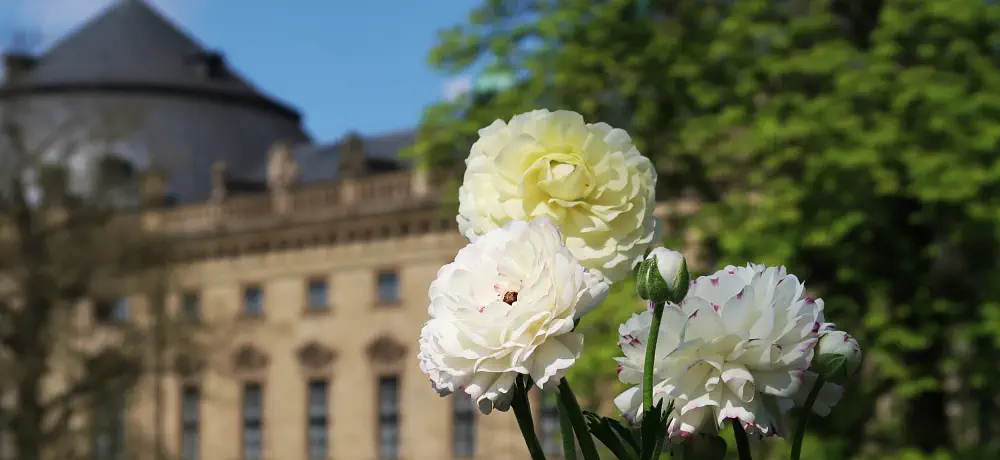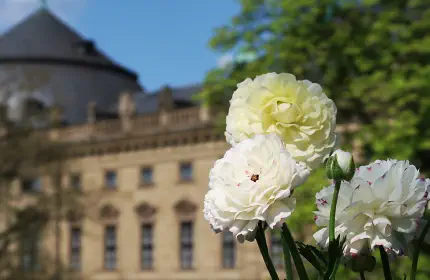



City Partner Hotel Wuerzburg
Wuerzburg is a great city and
always worth a visit - many
attractions await you

Wuerzburg Highlights
The most important Sights of Wuerzburg compiled for you
Wuerzburg is a beautiful city and always worth a visit.
Many sights are waiting to be explored by you. An absolute „must“ is the Residence
Palace, one of Europe´s most renowned Baroque castles.
Alte Mainbruecke
The „Alte Mainbruecke“ is the oldest Bridge in Wuerzburg.
There are 12 caracteristic statues of saints on it. Today people like
to meet on the bridge to drink a glass of wine.
Alter Kranen
The „Alter Kranen“ is a baroque harbour crane from 1773 and
one of the city´s landmarks, built by Balthasar Neumann´s son.
Buergerspital
Was founded in 1316 by wealthy citizens. With a small Gothic
church and picturesque courtyard with arcades from the 18th century.
Old and sick people were cared for there.
Cathedral of St. Kilian
The Wuerzburg Cathedral is a principal work of German architecture
from the 11/12th century, the fourth largest Romanesque church in
Germany and episcopal church of the diocese of Wuerzburg.
Falkenhaus
In the Middle Ages, the Falkenhaus was the residence of the cathedral priest.
The facade is one of the most beautiful rococo facades in southern Germany.
Today it houses the tourist information center and the city library.
Fortress Marienberg
The fortress Marienberg with „Mainfraenkischem Museum“ and
„Fuerstenbau Museum“ was originally a castle of refuge during the Hallstatt
period and later served as the seat of the Wuerzburg prince bishops.
Grafeneckart and Town Hall
The Grafeneckart is the oldest part of the Wuerzburg town hall
and was originally the seat of an episcopal official.
Juliusspital
The Juliusspital was founded by Prince-Bishop
Julius Echter von Mespelbrunn in 1576. It was at the same time an
old people´s home, hospital, orphanage and pilgrim hostel.
A rococo pharmacy with unique original equipment still exists today.
Kaeppele
The „Kaeppele“ pilgrimage church is located on the Nikolausberg.
The church was built according to plans by Balthasar Neumann (1752).
Reachable on foot via Stations of the cross with fourteen chapels.
Kulturspeicher
The Kulturspeicher is a converted warehouse from 1904,
which now houses a museum.
Marienkapelle
The Marienkapelle is a late Gothic period hall church from the
14th century and is located on Wuerzburg´s market square.
Neumuenster and Lusamgaertchen
The Neumuenster is a Romanesque basilica from the 11th century and
was built over the grave of St. Kilian and his companions, who were
murdered here as missionaries. At the back is the Lusamgaertchen
with the monument to the the minstrel Walter von der Vogelweide.
Residence Palace
The Wuerzburg Residence Palace is a principal work of southern
German Baroque, one of the most important castles in Europe and has
been a UNESCO World Heritage Site since 1981.
It was built according to the plans of Balthasar Neumann (1744).
Roentgen Memorial
The Röntgen Memorial houses the original laboratory
of Wilhelm Conrad Roentgen, where he discovered the X-rays
named after him in 1895.

Hotel Strauss - Juliuspromenade 5 - D-97070 Wuerzburg - Phone +49 (0)931 30570











Highlights of Wuerzburg

The most important sights of the city of Wuerzburg

City Partner Hotel Wuerzburg
Sights
Wuerzburg
Wuerzburg is a great city
and always worth a visit. Many
highlights are waiting to be explored by
you. An absolute „must“ is the
Residence Palace,
one of Europe´s most famous Castles.
Alte Mainbruecke
The „Alte Mainbruecke“ is the oldest
Bridge in Wuerzburg. On it there are 12
caracteristic statues of saints. Today
people like to meet on the bridge to
drink a glass of wine.
Alter Kranen
The „Alter Kranen“ is a baroque
harbour crane from 1773 and
one of the city´s landmarks. Built by
Balthasar Neumann´s son.
Buergerspital
Was founded in 1316 by wealthy
citizens. With picturesque courtyard
with arcades from the 18th century
and a small Gothic church. Old and
sick people were cared for there.
Cathedral St. Kilian
The Wuerzburg Cathedral is a principal
work of German architecture from the
11/12th century. The fourth largest
Romanesque church in Germany and
episcopal church of the diocese.
Falkenhaus
In the Middle Ages, the Falkenhaus
was the residence of the cathedral
priest. The facade is one of
the most beautiful rococo facades in
southern Germany. Today it houses
the tourist information center
and the city library.
Fortress Marienberg
The fortress Marienberg with
„Mainfraenkischem Museum“ and
„Fuerstenbau Museum“ was originally a
castle of refuge during the Hallstatt
period and later served as the seat of
the Wuerzburg prince bishops.
Grafeneckart and Town Hall
The Grafeneckart is the oldest part
of the Wuerzburg town hall
and was originally the seat of an
episcopal official.
Juliusspital
Juliusspital was founded by Prince-
Bishop Julius Echter von Mespelbrunn
in 1576. It was at the same time an
old people´s home, hospital,
orphanage and pilgrim hostel. A
rococo pharmacy with unique original
equipment still exists today.
Kaeppele
The „Kaeppele“ pilgrimage church
is located on the Nikolausberg.
The church was built according to
plans by Balthasar Neumann (1752).
The church is reachable on foot
via Stations of the cross with
fourteen chapels.
Kulturspeicher
The Kulturspeicher is a converted
warehouse from 1904,
which now houses a museum.
Marienkapelle
The Marienkapelle is a late
Gothic period hall church from the
14th century and is located on
Wuerzburg´s market square.
Neumuenster-Lusamgaertchen
The Neumuenster is a Romanesque
basilica from the 11th century
and was built over the grave
of St. Kilian and his companions,
who were murdered here as
missionaries. At the back
is the Lusamgaertchen with the
monument to the the minstrel
Walter von der Vogelweide.
Residence Palace
The Residence Palace is a principal
work of southern German Baroque, one
of the most important castles in
Europe and has been a UNESCO World
Heritage Site since 1981. It was
built according to the plans of
Balthasar Neumann (1744).
Roentgen Memorial
The Röntgen Memorial
houses the original laboratory of
Wilhelm Conrad Roentgen, where
he discovered the X-rays named
after him in 1895.





Hotel Strauss
Juliuspromenade 5
D-97070 Wuerzburg
Phone
+49 (0)931 30570


































